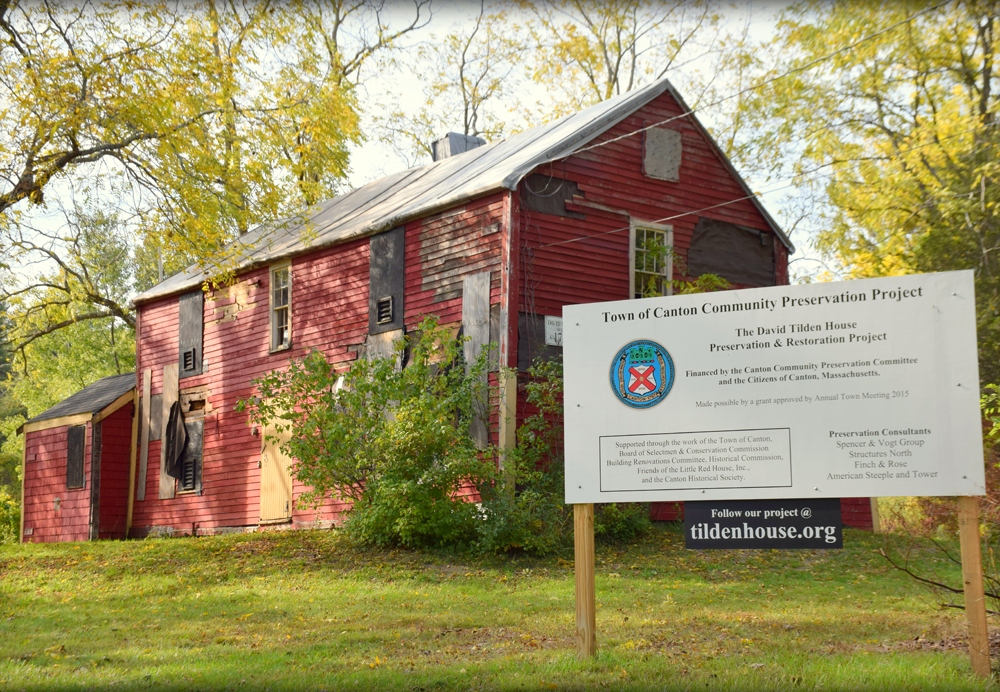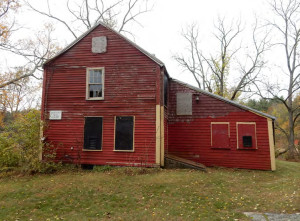Town at a crossroads with historic ‘Little Red House’
By Jay Turner
The David Tilden House at Pequitside Farm, known to locals as the “Little Red House,” is the subject of a major preservation project using Community Preservation Act funds. (Moira Sweetland photo)
Save me! Moaned the little red house,
… With eyes of wrinkled glass.
Save me! Groaned the old floor boards,
… Pegged in centuries past.
So begins the poem “Goodbye Little Red House,” penned by Doris Peters as both a lament and a rallying cry for the historic David Tilden House after it was ordered to be demolished by Canton’s then building commissioner in the late summer of 1973.
Purchased just a few years earlier as part of the town’s acquisition of the 32-acre Pequitside Farm recreation area, the small, timber frame house had stood on the same site for centuries but was no longer considered structurally sound due to significant rotting and sagging.
Faced with its imminent demise, a group of concerned local citizens would go on to form the nonprofit Friends of the Little Red House, Inc., and the group worked feverishly over the next five years to first rescue and then shore up the structure while also commissioning a detailed technical report that became the foundation for future studies and research on the house.
Today, nearly 45 years after the first demolition order was issued, the town once again finds itself at a crossroads with the Little Red House, and the situation, in some respects, is just as precarious as it was back in the early 1970s, according to current Friends President George Comeau.
On the one hand, a major preservation effort is already underway, backed by a Community Preservation Act grant of more than $400,000 that was awarded at annual town meeting in 2015. A team of preservation experts and consultants, led by the Spencer & Vogt Group, have since studied the house from top to bottom and have prepared an exhaustive historic structures report that documents existing conditions and offers detailed recommendations for preserving the house.
Yet the physical work that still needs to be done on the circa 1725 structure is both intricate and potentially more costly than originally anticipated — not to mention critically urgent — and it no longer seems feasible to have the town oversee the project.
The current overseers, the Building Renovation Committee, have arrived at this very conclusion, as have the stewards of the house, the Conservation Commission, as well as the town’s Board of Selectmen.
“This is a very complicated project,” acknowledged Comeau, who is one of the town’s foremost authorities on the Tilden House and its history. “It’s very hard to do a 300-year-old wooden house as a public project, and towns aren’t really set up to manage a project like this.”
The apparent solution, as recommended by Lynne Spencer, principal for historic preservation at Spencer & Vogt Group, is for the town to enter into a long-term lease agreement with a private nonprofit group (such as the Canton Historical Society) that would be responsible for the preservation, management, and upkeep of the house while the town retains full ownership. This would be similar to the arrangement that has been envisioned for the Paul Revere Heritage Site at the former Plymouth Rubber property, and Spencer said it is quite common and has been employed with great success in many other Massachusetts communities.
“This strategy,” she relayed, “effectively takes advantage of local volunteerism and community interest in turning what were considered ‘useless’ municipal liabilities into community assets by putting their management into private nonprofit hands with some kind of active use of community benefit. It also eliminates the public procurement process by virtue of the long-term lease and private financing. It is important to note that Community Preservation Act funds can be allocated to private nonprofit entities.”
Spencer said she has been involved with a number of these lease agreements, including the Buckman Tavern on the historic Battle Green at Lexington, which has been leased to the Lexington Historical Society for a term of 100 years. She cited other examples in her hometown of Nahant, as well as similar public/private arrangements for historic properties in Sudbury and Hull.
An article proposing such a lease for the Tilden House has been placed on the warrant for the upcoming May town meeting, and Comeau is cautiously optimistic that voters will see the wisdom of this strategy, noting that town meeting voters seem to appreciate “underdog stories.”
In terms of its historical significance, Comeau said the Tilden House is nearly unmatched in all of Canton, with a rich and meticulously documented lineage dating back to the early 1700s, when David Tilden, a farmer from Scituate, purchased 20 acres from the Ponkapoag Indians in what was then the “wilds of Dorchester.”
Tilden built the main portion of the house around 1725, and there were several subsequent additions, including a lean-to located in the rear of the house that may have already existed on the property in some form as early as 1709. Interestingly, the little “red” house was unpainted in its early years, and its first coat of paint, according to the historic structures report, was most likely “Greek Revival white.”
Even going by the 1725 date would make the Tilden House the second oldest surviving house in Canton after the Jonathan Puffer House (1711), located off Farrington Lane near the junction of routes 138 and 128. Furthermore, the Tilden House is one of only a handful of First Period houses still remaining in all of Norfolk County; by comparison, Essex County, the other early settlement of the Massachusetts Bay Colony, preserves over 400 First Period houses, according to Spencer.
“This building is early and specifically there are not many early buildings in this part of Massachusetts,” she said. “I think it’s got meaning and significance to the Canton community and tells the story of durability and persistence.”
As for the preservation work that is needed, Comeau said it was originally slated to begin this past summer and “can’t happen soon enough.”
The first phase will consist of “anything structural,” he said, including the removal of all rotted wood as well as installation of a new roof and some minor masonry work. Phase two, which will happen at a later date utilizing a combination of private and public money, will focus on windows, doors, and interior improvements.
Comeau said there is a significant amount of rot, particularly in the oldest portion of the house, but he estimates that “60 percent of the original material will still be there when it’s finished.”
“To the untrained eye, there is no question that this is a building in very tough shape,” he said. “To the trained eye, this is a building that is ready to be remodeled and preserved.”
At the same time, Comeau said he worries about the condition of the house “constantly,” and Spencer characterized the Tilden House as “one of the more challenged” buildings that she and her team has ever worked on. “It’s not beyond recovery, but it’s right at the edge,” she said.
Both Comeau and Spencer envision the Tilden House functioning as a “learning lab” for interested craftsmen and architecture students both during and after construction. And while it will likely never function as a full-fledged museum, Comeau would at least like to see it be opened seasonally for school groups and others interested in learning about the history of one of Canton’s oldest houses.
But the key to all of it, he said, is the approval of the lease agreement at annual town meeting, after which the project could then “begin in earnest.”
“This has been a big part of my life for the last 15 years and it’s been a big part of the town’s history for almost 300 years, and I feel as though we’re destined to save this house for future generations,” he said. “It’s been a project that’s more difficult than I ever imagined, but I think this is a wrinkle that we’re going to get through.”
“Fifty years from now, fourth graders are going to look at this and say, ‘Wow,’” predicted Comeau. “It’s going to be amazing when it’s done.”
For more information about the history and preservation of the David Tilden House, go to www.tildenhouse.org.
Short URL: https://www.thecantoncitizen.com/?p=35469











